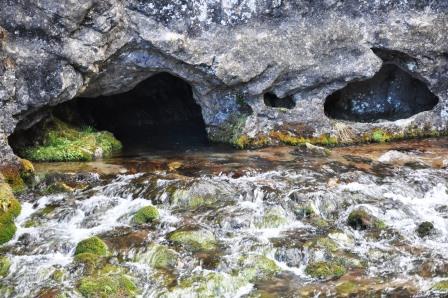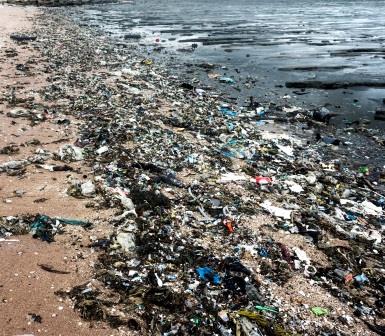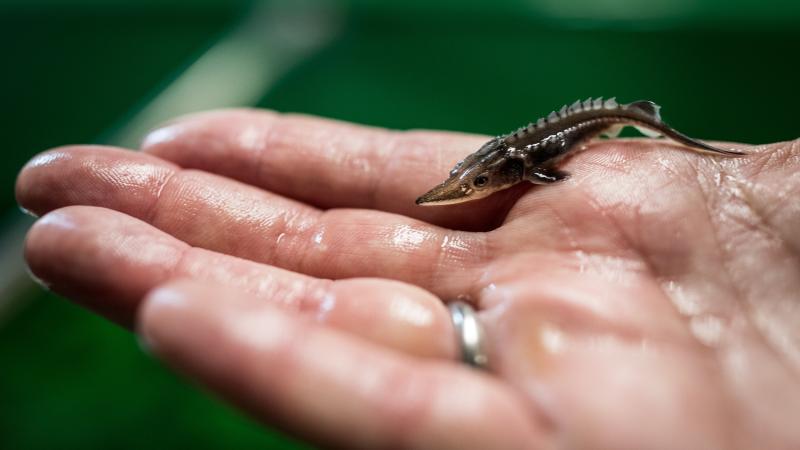
The cycle of water | Graphic: Christiane John
Where does the water come from?
Water falls from the sky as rain, snow, hail or it is available as steam. Water that reaches the ground either is running on the surface to the lower sections of land, forming water runs and ditches or it enters the ground, passes the soils and mineral layers and ends up as groundwater. On its way it might end up being drawn in by plant roots for growth. In cold climate water aggregates and snow and ice such as the glaciers.
A large proportion of the rainfall and some of the groundwater end up in the surface waters such as rivers. They discharge the water that is not retained by plants and soil. The further downstream the river goes, the more tributaries it collects and the more water it contains until it discharges into the sea, which comprises 2/3 of the surface of our planet.
The radiation of the sun warms the surface of water bodies, allowing water molecules to start evaporating and becoming gaseous. This evaporation reaches approx. 500 trillion liters of water per year from the oceans alone. Water that evaporates travels up into the air, reaches higher strata and begins cooling down. Condensation changes the state of the water from gas to liquid and tis liquid is present in little droplets that form the clouds. These clouds are transported with the wind and as soon as they reach a barrier, for instance a mountain, which shifts them in to higher elevations, the water cools down even more, the droplets become larger and rainfall sets in. This water again falls down to earth to refuel the ground and river water.
 Migratory fish | Photo: 123rf
Migratory fish | Photo: 123rf
Who and what travels with or in water?
Biological diversity
Rivers serve as linkage between land and sea. They are a means of transport for a large variety of organisms. Some use the river for passive transport such as the plankton which ends up in the sea at the end of its journey. Other species are able to maintain position and move in different directions is called nekton. This group also includes the fishes that make use of their special bodyshape and skin as well as the fins to move freely in the current. The connection between river and sea as well as the huge performance of traveling hundreds of kilometers in them is one of the remarkable characteristics of migratory fish.
 Erosion | Photo: Pixabay
Erosion | Photo: Pixabay
Sediments and suspended solids
Since water with its viscosity and energy develops considerable power stones and sand are transported along its way. The erosion process, the removal of sediments, and their disposition in areas with lower current velocity and thus lifting power, so called sedimentation, varies both with gradient of the river bed and the energy disipitation that takes place when water hits the ground. Through these processes the river forms its landscape, it establishes meanders and islands, deposits material in some places, excavating it in others. In the river mouth area the current decreases and the sediments start to sink, providing a nutrient rich floodplain.
 Waste on the beach | Photo: 123rf
Waste on the beach | Photo: 123rf
Nutrients and wastes
Rivers are sinks of the landscape. They are the lowest point in their vicinity and as such they collect all sources of liquid transport. The soluble compartments of our wastes including pesticides, herbicides, fertilizers and production byproducts also are transported this way. These components are transported to the sea with the water and as such do not only harm the river ecosystems but also the coastal systems. This input in the first place explains why coastal waters are much more productive that the open blue sea.
Can a cycle be disturbed?
Water is permanently recycled on Earth. It flows from land via the rivers into the sea. Evaporation over the seas supports the formation of clouds that drift ashore and where precipitation feeds the groundwater and the rivers again. But how does it come that rain is not salty and the sea is not getting more sweet from time to time?
As long as the physical background does not change the water cycle persists, evaporation only allows water to go over into gaseous form, the minerals are left behind. This maintains freshwater for the terrestrial ecosystems and maintains the salt contents for the marine species. To prevent the increase of salt concentration in the sea, fresh water needs to be refilled which takes place both through the rain and the river discharge.
Human impact has resulted in an imbalance of the cycle though. In Kazakhstan this becomes obvious in the area of the Aral Sea, the world’s 4th largest inland sea in the 1960s. Then cotton fields were irrigated with water from the main three tributaries. This slowly but steadily led to the shrinkage of the sea, which today only comprises approx. 30% of the historic size. But also river constructions, leading to the increased erosion and transport of sediments, show similar effects in what before were wetlands that get disconnected from the groundwater and start to die off reducing the habitat for aquatic life at a large scale.



